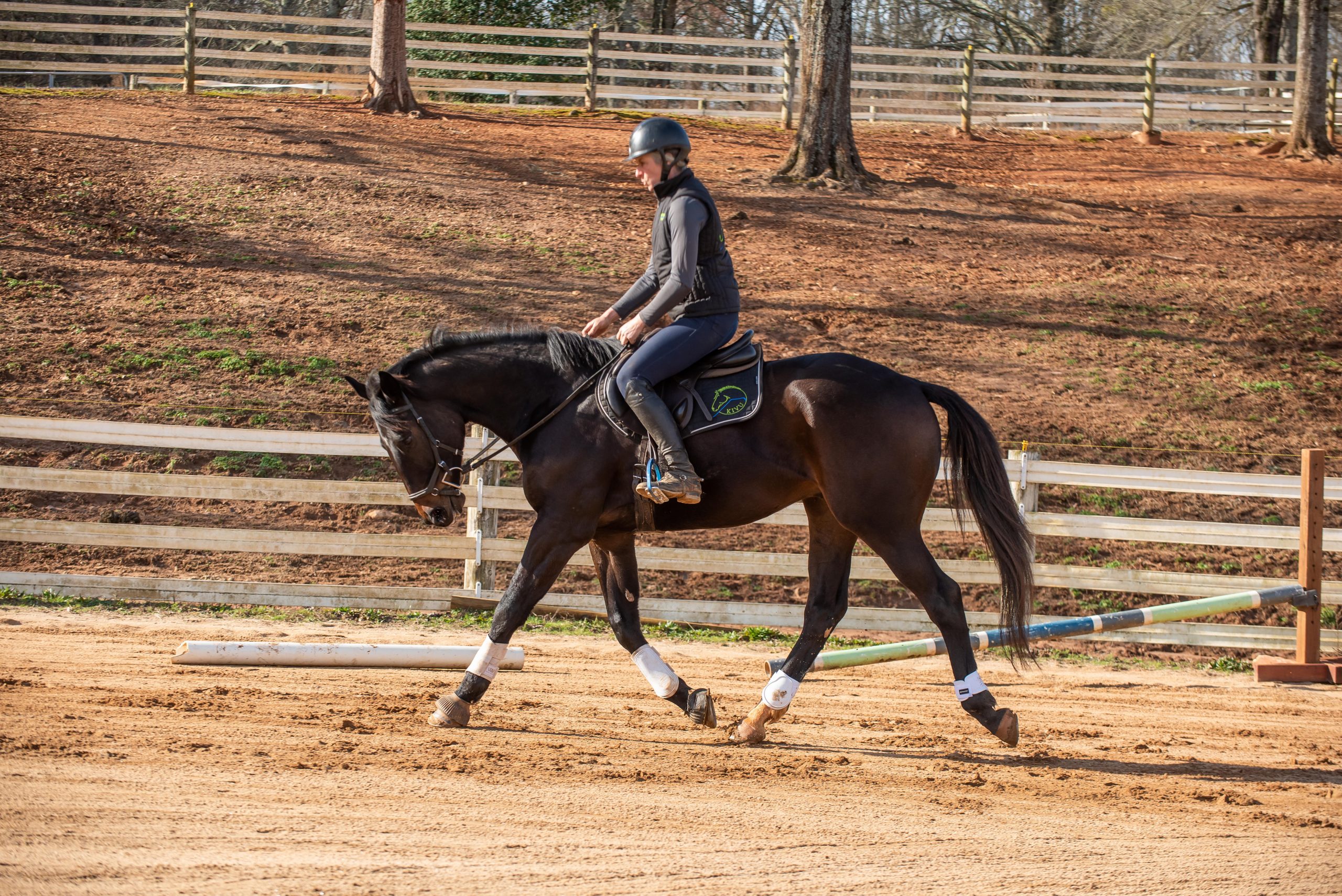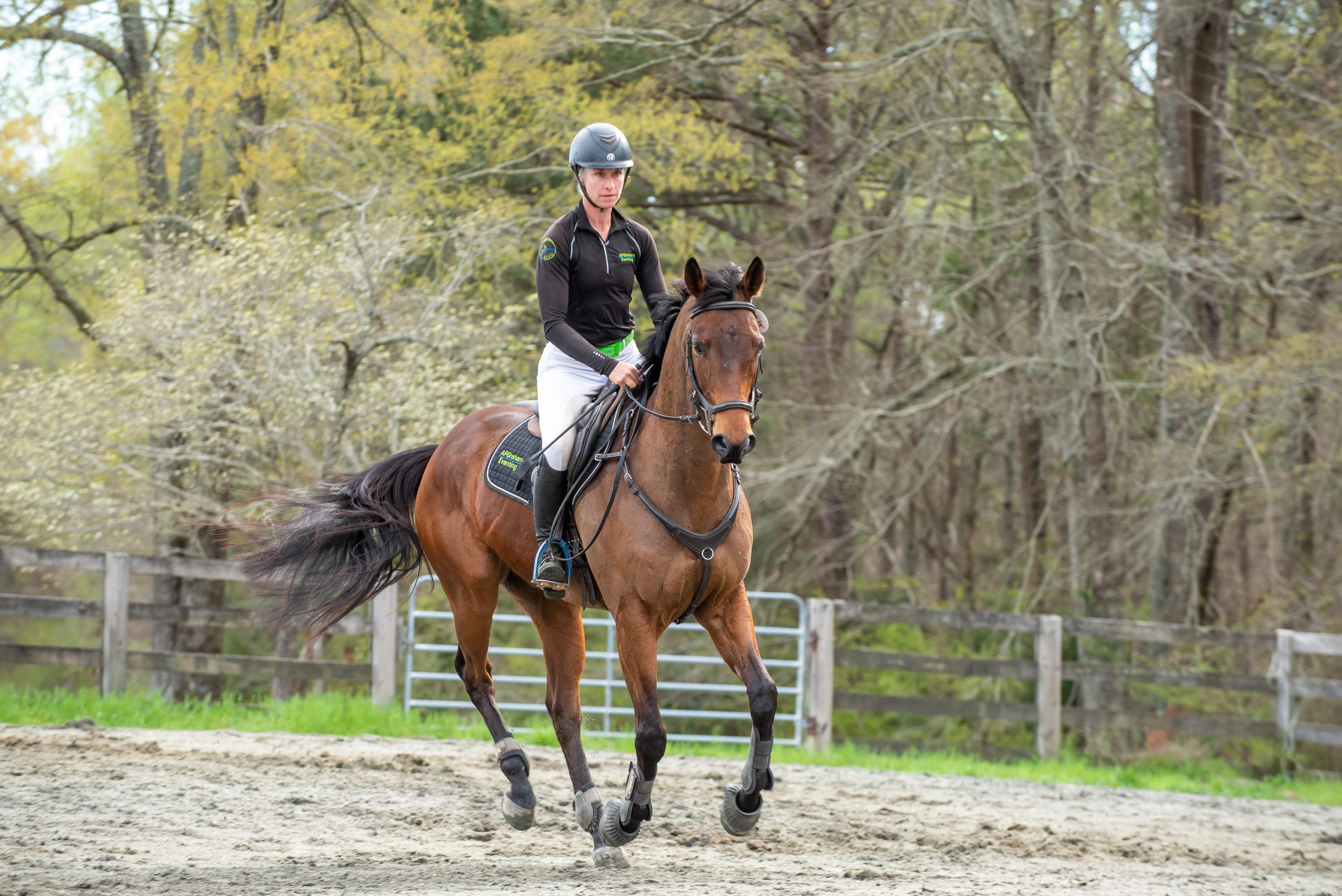
Thoroughbred Logic: Finding the Flow
“In riding, whether flatting, jumping, executing a dressage test, or smartly blasting around cross country, we all think about rhythm and pace. While we have a lot of terms to get at the quality of a round, I think the idea of ‘flow’ is due an equine resurgence.”
Welcome to the next installment of Thoroughbred Logic. In this weekly series, Anthropologist and trainer Aubrey Graham, of Kivu Sport Horses, offers insight and training experience when it comes to working with Thoroughbreds (although much will apply to all breeds). This week, come along for the ride as Aubrey offers her logic on finding flow while riding.
Most days, I kick myself for having gone back to teaching at Emory for the year. Don’t get me wrong, I love teaching. I also don’t think having good health care while training green horses to event is a poor life choice. However, I just patently don’t have time. I didn’t have enough hours in the day without returning to academia. Now I am just trying to pull them out of even thinner air. So, I, like my Seniors, am counting down to the last day of this semester.
But for once (besides the insurance and a steady paycheck) being back at Emory has been helpful. Before spring break, I asked one of my classes to make Ethnographic films of a topic of their choice. Without sounding like, well, a professor, this meant they had to think like an Anthropologist, film longer cuts, and let the images “show” something and produce knowledge along the way — no Morgan Freeman voice over, no telling the viewer what they were supposed to see. One talented set of students filmed at a skate park in Atlanta.
View this post on Instagram
Their film clips followed the skaters from when they pop their ear buds in and push off over the top of the pike down onto the concrete slopes, turns, and valleys. It tracks them in a smooth line while they traverse the park in one respective pass, throwing in jumps and turns, grabs and various artistic-athletic, but totally nonchalant, badass moves (because, skaters). The students cut the ambient sound and instead inserted a song, as if the viewer is experiencing this in the same noise canceling way as the skater. The combination is hypnotic. There is so much going on, but at that moment, there is nothing but the flow.
In riding, whether flatting, jumping, executing a dressage test, or smartly blasting around cross country, we all think about rhythm and pace. While we have a lot of terms to get at the quality of a round, I think the idea of “flow” is due an equine resurgence. Flow deals with the creation of a continuous stream — something that moves evenly, seamlessly… to be all zen about it… like flowing water over stones. Or you know, like a seasoned skater chick through a skate park. Cool.
With horses, I’m certain you know it when you see it — the jumper rounds that are so even that it looks effortless (it of course is far, far from). The dressage that leaves you wishing you had the money to buy a horse that “goes around like that.” And the cross country runs that make getting from Advanced fence to Advanced fence look like a leisurely gallop in the park. They all flow.

“Flow” might be visible at the highest levels of the sport, but practice starts at home well before the red numbers. Louis (Unbridled Bayou) has been getting better and better at riding off my leg. Photo by Kelly Robison.
That doesn’t mean there aren’t pace changes, extensions and collection; it doesn’t mean direction doesn’t change, or the amount of impulsion doesn’t increase or decrease. It means that the forward-going power of the horse is not checked — rather it is channeled — and their balance is not altered. It means that they are riding from their hind end and driving up into the bridle. And because of that, it means that they are able to make smooth transitions and turns, jump out of stride and shift between gaits without it looking like a computer simulation glitch. With an equally poised, capable rider, that impulsion and balance work towards a seamless performance.
Flow, as it turns out, ain’t easy.

Madigan Cat was a bit of a handful at the last Big Cheese show, so instead of increasing his jump size, we aimed for smoother rounds. The result? He just cantered the bitty fences like they were cavalettis. Perfect. Photo by the Kivu Team.
The idea of “flow” is an idea that is a holistic, whole package, horse and rider together thing. And the ability to flow well while doing athletic feats not only means both horse and rider share a fair amount of trust, but also it means they are bloody strong. It is about having enough core strength and leg strength to maintain balance without going to your hands or letting the horse collapse on their forehand. It is about the ability to lift and support without restraining or holding. It is about turning without grabbing the inside rein and upending their balance. And it is about riding off your leg and seat and using your hands to guide and finesse, not as the primary control mechanism. Like all things that must be both graceful and athletic — gymnastics, any form of dance, even — dare I say? — football, skating of all kinds (the list could go on and on here). Such balance, power, and the ideal seamlessness between movements all come from a base of strength that cannot be skipped.
Since I have been thinking about skateboarders and the seemingly effortless-but-actually-super-effort-ful flow, I have been working through various riding exercises at home that seem to help. Once on and going and warmed up on a loose rein, I pick up a soft contact and ride without moving my hands (besides stretching breaks) or changing my balance. I trot paisley designs, figure eights, serpentines, then canter them, walk on the diagonal, back to canter, etc. I focus on steering from my leg, seat and the turn of my hips and shoulders, avoiding using my reins. As the horse figures out that I will not be “leading” him around the turn, they start to improve their balance, moving off your outside leg, carrying themselves, becoming more attuned to the quiet shifts of a ring finger and calf that indicates the tightness of a roll back.

Madigan Cat at the Thoroughbred Logic Clinic last month, working on his forward flow and soft connection. Photo by Cora Williamson.
This has turned out to be super helpful, particularly with Rhodie (Western Ridge), who has such a sensitive, dragon-ly disposition (especially when you ask him to collect). I have been playing at riding one handed at home, schooling all the things we usually do, but with a western rein carriage (western riders would laugh at me doing this). Yes, we look ridiculous. I don’t care. Alternatively, I bridge my reins, set them on his wither and ride the whole school off my leg and seat. Doing things that way will definitely tell you how much you’re not using your leg and seat when the hand is more available to help. But in the process, by not moving my hands, by not checking his forward motion, and by riding almost exclusively off my leg and seat, there is the start of a flow… even in a flat school.

Rhodie (Western Ridge) warming up on soft contact at Poplar Place Farm last weekend. Photo by Cora Williamson.
So when, at the last show, we went into our Training Level stadium round, I set my contact and tried to ride from there without a big change to any fence. (This is also of course, just an extension of the “just don’t move” article from a few weeks ago.) The first few fences went great. When we came to the one stride, we were deep and I honestly am not sure what happened except Rhodie’s catty footwork and sheer athleticism saved us and kept all the sticks up. I stayed as still as I could while he hucked himself without any style or bascule through to the other side of the combo, thanked him for having good footwork, and was shocked when he stayed ridable to the next fence, and then the two stride, and then well… the rest of the whole damn course.
Despite the “oh shit” moment at the one stride, my notoriously unforgiving horse never even thought about getting mad. When I looked back at the video, sure the one stride looks like total trash, but I grabbed mane and stayed back and stayed with him. He got through it and carried on. It might have been ugly, but it never upset his forward movement, overall balance, and hind-driving power. Huh. Flow to the rescue apparently.

Rhodie remain quite scopey and ridable through the rest of the course at Poplar. Photo by Cora Williamson.
So while that round sure didn’t flow half as well as Tony Hawk through the half pipe, or as well as the skaters my students filmed, it nonetheless had the makings of getting there. There is certainly homework, but I’m excited to see where a serious focus on this notion of flow takes not just Rhodie, but all of my horses. Hell, at very least, it will make my legs and core stronger and keep me more able to stay out of the way when the chips are down.
So hey, if this concept is what I get from another semester of getting to teach some of the South’s most talented students, I’ll take it. But I’ll still be counting down the days until the last class and the happy return to full-time-Thoroughbreds.
Happy riding folks — go find the flow.







